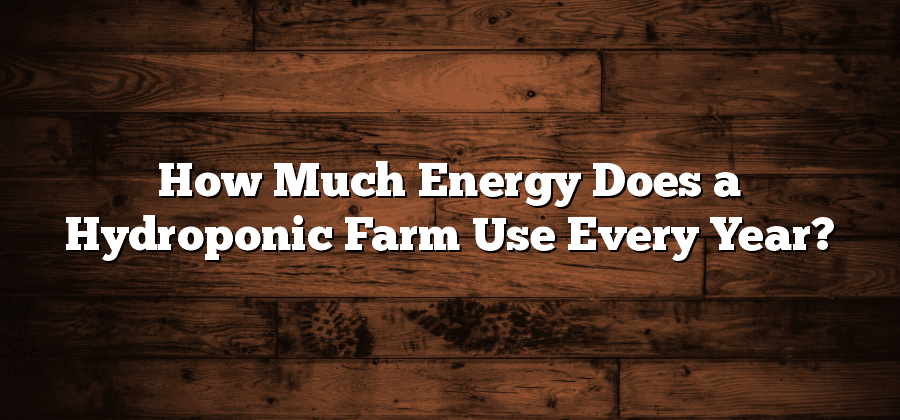Understanding the Energy Requirements of Hydroponic Farms
Hydroponic farming, a method of growing plants without soil, has gained significant attention in recent years due to its potential for sustainable food production. However, one aspect that often goes overlooked is the energy requirements of these advanced farming systems. Understanding the energy needs of hydroponic farms is crucial for optimizing efficiency, reducing costs, and minimizing environmental impacts.
The energy requirements of hydroponic farms can vary depending on several factors. One key consideration is the type of lighting system used. Artificial lighting is essential for indoor hydroponic setups, as it replaces the natural sunlight needed for photosynthesis. High-intensity discharge (HID) lights, such as metal halide and high-pressure sodium lamps, are commonly used due to their high output and ability to mimic sunlight. However, they can be energy-intensive and may lead to high electricity bills. On the other hand, light-emitting diode (LED) technology has shown promise in providing energy-efficient lighting solutions for hydroponic farms. LED lights consume less electricity, produce less heat, and can be tailored to deliver specific light spectrums required for plant growth. As such, the choice of lighting system can significantly influence the energy consumption of hydroponic farms.
Key Factors Influencing Energy Consumption in Hydroponic Farming
Energy consumption is a critical consideration in hydroponic farming, as it directly impacts the financial and environmental sustainability of the operations. Several key factors influence energy consumption in hydroponic farming, and understanding and optimizing these factors are essential for maximizing efficiency.
One of the primary factors influencing energy consumption in hydroponic farming is the choice of lighting system. The lighting system plays a crucial role in providing the necessary light spectrum and intensity for plant growth. However, different lighting systems have varying energy requirements, and choosing the right system can significantly impact energy consumption. High-intensity discharge (HID) lights, such as metal halide and high-pressure sodium lamps, are commonly used in hydroponic farming due to their effectiveness in promoting plant growth. However, these systems tend to have a higher energy consumption compared to newer technologies like light-emitting diodes (LEDs). By evaluating and comparing the energy efficiency of different lighting systems, hydroponic farmers can make informed decisions that balance energy consumption with plant growth and productivity.
Evaluating the Impact of Lighting Systems on Energy Usage
The impact of lighting systems on energy usage in hydroponic farming is a crucial aspect to consider when evaluating the overall energy requirements of such farms. Lighting plays a pivotal role in providing the necessary light spectrum for plant growth, particularly in indoor setups where natural sunlight is limited. However, it is important to assess the efficiency of the lighting systems to prevent excessive energy consumption.
One factor influencing energy usage in lighting systems is the type of light source utilized. Traditional lighting options such as high-pressure sodium (HPS) lamps are known to be energy-intensive. On the other hand, Light Emitting Diodes (LEDs) have gained popularity in recent years due to their energy efficiency. LEDs offer a more targeted light spectrum, allowing for better control and optimization of energy consumption. By choosing the right type of lighting system and incorporating smart lighting controls, hydroponic farmers can potentially reduce energy consumption while still providing adequate light for plant growth.
The Role of HVAC Systems in Energy Consumption of Hydroponic Farms
Hydroponic farming, with its controlled environment and precise nutrient delivery systems, is becoming increasingly popular for its potential to provide sustainable farming solutions. However, the role of HVAC (Heating, Ventilation, and Air Conditioning) systems in hydroponic farms cannot be overlooked when assessing energy consumption. HVAC systems play a vital role in maintaining the ideal temperature, humidity, and air quality necessary for plant growth, but they can also be a significant source of energy usage.
The energy consumption of HVAC systems in hydroponic farms can vary depending on factors such as farm size, climate, crop type, and desired environmental conditions. The cooling aspect of the HVAC system is often the main contributor to energy usage, as it requires the use of air conditioners or chillers to maintain the optimum temperature for plant growth. Additionally, the ventilation component of the system is responsible for removing excess heat, humidity, and carbon dioxide from the growing area, ensuring a healthy environment for the plants. Balancing these requirements with energy efficiency is a crucial consideration for hydroponic farmers looking to minimize operational costs and environmental impact.
Assessing the Energy Efficiency of Water Pumps and Nutrient Delivery Systems
In hydroponic farming systems, water pumps and nutrient delivery systems play a crucial role in supplying water and essential nutrients to the plants. However, it is important to assess the energy efficiency of these components to ensure sustainable and cost-effective operations.
Water pumps are responsible for circulating the nutrient solution throughout the hydroponic system. The energy efficiency of water pumps can be evaluated by considering factors such as power consumption, pump capacity, and operating hours. High-efficiency pumps that consume less energy while providing adequate flow rates can significantly reduce energy usage in hydroponic farms. On the other hand, inefficient pumps may consume excessive energy, leading to increased operational costs and environmental impact.
Similarly, nutrient delivery systems, including injectors and dosers, need to be assessed for their energy efficiency. These systems are responsible for accurately delivering the required nutrients to the plants. By evaluating the energy consumption of nutrient delivery systems, farmers can identify opportunities for optimization and improvement. Efficient dosing systems that minimize energy waste and ensure precise nutrient delivery can contribute to improved resource management in hydroponic farms.
Assessing the energy efficiency of water pumps and nutrient delivery systems is vital for the long-term sustainability of hydroponic farming. By identifying opportunities for improvement and implementing energy-efficient solutions, farmers can reduce operational costs, minimize environmental impact, and enhance the overall efficiency of their hydroponic systems.






